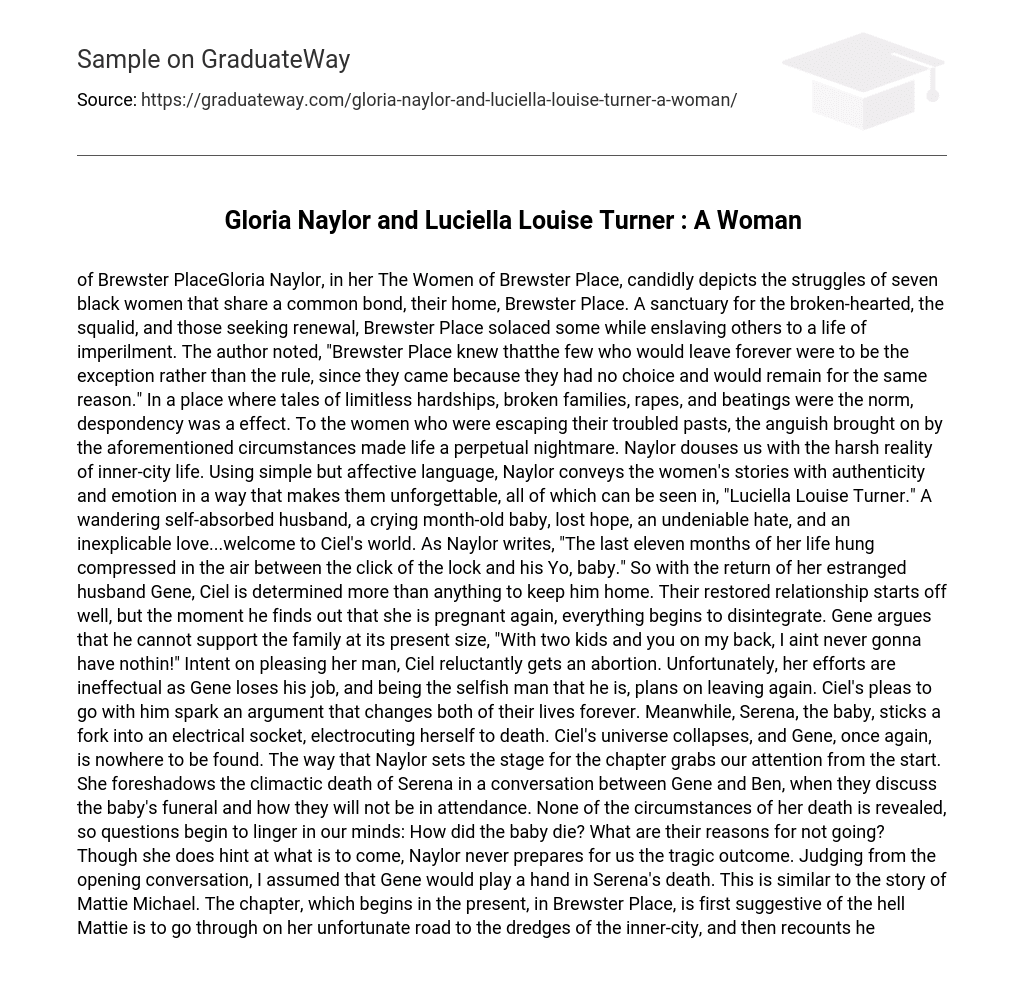of Brewster PlaceGloria Naylor, in her The Women of Brewster Place, candidly depicts the struggles of seven black women that share a common bond, their home, Brewster Place.
A sanctuary for the broken-hearted, the squalid, and those seeking renewal, Brewster Place solaced some while enslaving others to a life of imperilment. The author noted, “Brewster Place knew thatthe few who would leave forever were to be the exception rather than the rule, since they came because they had no choice and would remain for the same reason.” In a place where tales of limitless hardships, broken families, rapes, and beatings were the norm, despondency was a effect. To the women who were escaping their troubled pasts, the anguish brought on by the aforementioned circumstances made life a perpetual nightmare. Naylor douses us with the harsh reality of inner-city life. Using simple but affective language, Naylor conveys the women’s stories with authenticity and emotion in a way that makes them unforgettable, all of which can be seen in, “Luciella Louise Turner.” A wandering self-absorbed husband, a crying month-old baby, lost hope, an undeniable hate, and an inexplicable love…welcome to Ciel’s world.
As Naylor writes, “The last eleven months of her life hung compressed in the air between the click of the lock and his Yo, baby.” So with the return of her estranged husband Gene, Ciel is determined more than anything to keep him home. Their restored relationship starts off well, but the moment he finds out that she is pregnant again, everything begins to disintegrate. Gene argues that he cannot support the family at its present size, “With two kids and you on my back, I aint never gonna have nothin!” Intent on pleasing her man, Ciel reluctantly gets an abortion. Unfortunately, her efforts are ineffectual as Gene loses his job, and being the selfish man that he is, plans on leaving again. Ciel’s pleas to go with him spark an argument that changes both of their lives forever.
Meanwhile, Serena, the baby, sticks a fork into an electrical socket, electrocuting herself to death. Ciel’s universe collapses, and Gene, once again, is nowhere to be found. The way that Naylor sets the stage for the chapter grabs our attention from the start. She foreshadows the climactic death of Serena in a conversation between Gene and Ben, when they discuss the baby’s funeral and how they will not be in attendance. None of the circumstances of her death is revealed, so questions begin to linger in our minds: How did the baby die? What are their reasons for not going? Though she does hint at what is to come, Naylor never prepares for us the tragic outcome. Judging from the opening conversation, I assumed that Gene would play a hand in Serena’s death.
This is similar to the story of Mattie Michael. The chapter, which begins in the present, in Brewster Place, is first suggestive of the hell Mattie is to go through on her unfortunate road to the dredges of the inner-city, and then recounts her surprisingly traumatic past. It is this unpredictable quality that is seen throughout that adds intrigue to the novel. Perhaps the novel’s best attribute is its realism.
Though some have said the book was too lurid and depressing–that is real life; not everything has a happy ending. People are condemned to lives of poverty, women do get raped and beaten, as Lorraine was, kids do fail out of school, like Cora Lees, wives and children are neglected, and sometimes there is no hope–that is reality. What happens to Ciel happens to normal every-day people. The idea of losing a husband and a child is very sad, but not far-fetched. In The Women of Brewster Place, sex plays a key role in the women’s lives.
Ciel’s undoing is caused by the “raw urges that crept, uninvited, between her thighs on countless nights” she suffers as a result of not always having a man around. After Ciel and Gene reunite, the ensuing sexual encounter results in a pregnancy that ruins their lives. Others’ suffering is due to their promiscuous ways, or the disapproval of their sexual orientation. If Naylor’s objective were to write a book that not only gave an in-depth look into the lives of black women but captured the readers’ hearts as well, she succeeded.
By dropping hints out of context, as she does in “Luciella Louise Brown,” she spurs our interest from the start, and never ceases to surprise us at the end. In refusing to overlook any aspect of inner-city life, both the good and bad, Naylor strengthens her book’s validity. Some passages may be considered risqu or too disheartening, but they contribute to the true-to-life feel of the novel. Naylor’s ability to seize the audience’s attention, coupled with her willingness to give the most lifelike story, makes The Women of Brewster Place an unforgettable book.





